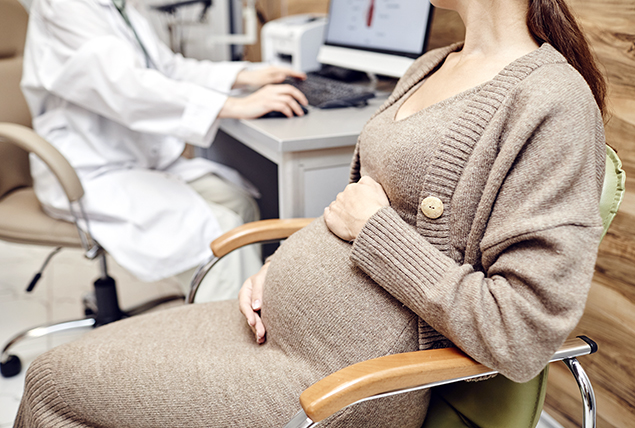What Should You Know About Cervical Cancer and Pregnancy?

Cervical cancer during pregnancy isn't common. But in the rare instance that a tumor is found in the cervix and growing simultaneously with a fetus in the womb, you might wonder how it will affect your health and your baby's.
Healthcare providers consider several factors when determining the right course of treatment. Here's what you should know.
How do you get diagnosed with cervical cancer when you're pregnant?
Pregnancy doesn't cause cancer or increase someone's risk of cancer, according to the Canadian Cancer Society. In fact, a 2001 study indicated a link between pregnancy and a decrease in ovarian cancer, while a 2019 study suggested a reduction in the risk of endometrial cancers.
Cervical cancer during pregnancy is usually diagnosed at an early stage. Many women don't have symptoms during the beginning stages of cervical cancer.
Later symptoms, however, may include pelvic pain, vaginal bleeding and pain during sex, according to The Bump.
Monte Swarup, MD, FACOG, a Chandler, Arizona-based OBGYN, described a three-step cervical cancer screening process.
Cervical cancer testing includes:
- Pap smear, or cervical cytology
- Colposcopy
- Cervical biopsy
This kind of cancer may be discovered during an abnormal human papillomavirus (HPV) or Pap test result. If a test is abnormal, it indicates a need for further testing and is not a confirmation of cancerous cells.
A colposcopy follows. An obstetrician-gynecologist (OB-GYN) uses a special magnifying device, called a colposcope, to get a better view of the cervix, vagina and vulva, according to the American College of Obstetricians and Gynecologists (ACOG).
During the colposcopy, the OB-GYN may notice unusual cells. Generally, biopsy is avoided during pregnancy unless the colposcopes finding is concerning for severe dysplasia or cancer.
During pregnancy, the increased blood flow to the uterus and cervix is greater and heightens the risk of bleeding after a biopsy. Physicians may vary a bit, but if the cervix looks okay on the colposcopy, the biopsy and endocervical curettage (EDD) may be postponed until the patient delivers
After delivery, if a biopsy is necessary, a small bit of tissue will be removed from the cervix, vulva or vagina and tested. An ECC may be used to remove cells from the canal of the cervix for further testing.
If a colposcopy can't determine the cause of cancer, a cone biopsy (conization or cold knife biopsy) may help diagnose cancerous or precancerous cells. A cone biopsy is also a treatment option to remove early-stage cervical cancer (stage 0 or IA1), according to the Cleveland Clinic.
What are the treatment options for someone diagnosed during pregnancy?
It can take a long time for cervical cancer to develop. In women with typical immune systems, it takes 15-20 years on the average for cancer of the cervix to develop, according to the World Health Organization (WHO).
What is the best way forward when a pregnant woman is diagnosed with cervical cancer? Treating cervical cancer is individualized based on a patient's needs, overall health, the stage of the cancer and how many weeks pregnant the person is.
A 2013 study listed three standard options a patient has when considering what to do when they are pregnant and diagnosed with cancer.
The options are:
- Treat cervical cancer concurrently with the pregnancy, such as through abdominal radical trachelectomy.
- Wait to give birth before commencing cancer treatment.
- Surgically terminate the pregnancy if it’s within the first or second trimester at the time of diagnosis and proceed with treatment.
For example, those continuing with their pregnancy in the first trimester with a slow-growing stage one cancer may be induced at 37 weeks via a Cesarean section (C-section) and receive a hysterectomy, or surgery to remove the cervix and uterus, at the same time, according to the National Cancer Institute.
But, for people with stage II, III, or IV cervical cancer in the second or third trimester, treatment, such as chemotherapy, may be recommended. You may be scheduled for a C-section and recommended for other treatment, such as a hysterectomy and radiation therapy (chemotherapy).
Again, any form of treatment would depend on gestational age, how far the disease has progressed, and the patient's histology, Jackyline Prestosa, MD, OBGYN, based in Hawaii, explained. Physicians are required to offer patients extensive counseling regarding the risks to both maternal and fetal health.
What is a multidisciplinary approach to treatment?
Several factors, and the patient's decision to continue or terminate the pregnancy, are discussed with a multidisciplinary healthcare team to determine a treatment plan. This wasn't always the case.
Prestosa adds that previously, treating cervical cancer during pregnancy was never considered an option. For the most part, those who developed cervical cancer during pregnancy or discovered that they were pregnant when diagnosed with the disease were advised to terminate their pregnancies within the first and second trimesters.
Otherwise, treatment of the disease would be held off until the patient gave birth. Then, a standard cancer treatment regime, such as chemotherapy and radiation, would follow postpartum.
Today, allowing a patient's pregnancy to continue even while undergoing cancer treatment is possible thanks to a team made up of their obstetrician, oncologist, mental health specialist and critical care nurses.
How common is cervical cancer in pregnancy?
The incidence of cervical cancer among pregnant women is roughly 0.1 to 12 in 10,000 pregnancies, reported a 2013 study. Those diagnosed as positive for cervical cancer were older than 35 and lived in middle-class economic circumstances. This group also had more cesarean births, transfusions and hysterectomies.
On the other hand, cases of cervical intraepithelial neoplasia (CIN), a precancerous condition or cervical dysplasia, were 1.30 to 2.7 per every 1,000 pregnancies. Patients diagnosed with CIN tended to be under the age of 35, seemed to have less income and were likely dependent on government welfare for medical assistance.
This group also tended to have fewer incidences of cesarean delivery, blood transfusions and cesarean hysterectomies.
Given the rarity of the disease and all the factors considered, standardizing a course of treatment for cervical cancer in pregnancy remains a challenge for the medical community despite numerous attempts to come up with clinical practice guidelines.
Rarity, as well as the potential risks to both mother and fetus, have also made extensive clinical trials and randomized studies impossible.
What are the symptoms of cervical cancer in pregnancy?
Early-stage cervical cancer isn't obvious. It can mimic menstrual bleeding, except it may be longer or heavier and happen between periods, or spotting, the City of Hope shared.
Post-coital vaginal bleeding, with or without pain, remains a common symptom of late-stage cervical cancer. Other symptoms include abnormal vaginal discharge, pain in the pelvic region or changes in vaginal discharge.
While pelvic pain and heavier vaginal discharge are common enough during a healthy pregnancy, these may also occur in patients with more advanced cervical cancer.
The bottom line
A positive cervical cancer diagnosis offers different treatment options based on the number of weeks pregnant and the cervical cancer stage of the patient. The healthcare provider will help you determine the best course of action based on several factors, including your current health, age and the cancer stage.
Routine cervical cancer screening is important. Early diagnosis leads to better outcomes.


















